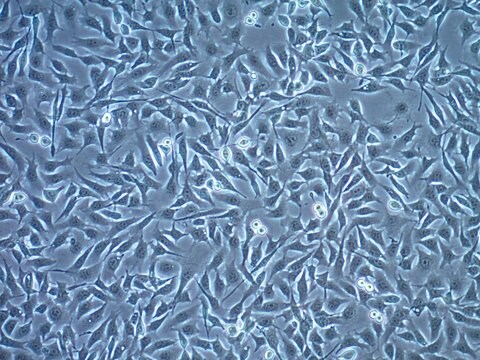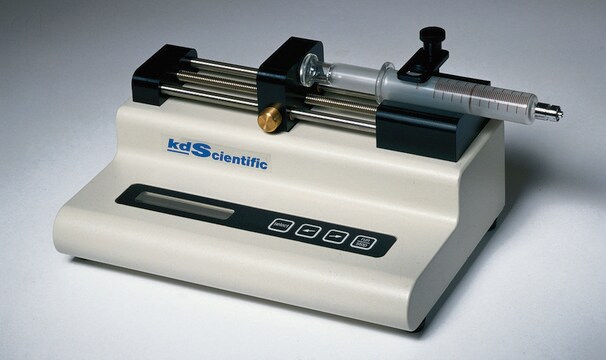SCC246
YUMMER1G.1F Mouse Cell Line
Autenticatiper visualizzare i prezzi riservati alla tua organizzazione & contrattuali
About This Item
Codice UNSPSC:
41106514
NACRES:
NA.81
Prodotti consigliati
Origine biologica
human
Livello qualitativo
Confezionamento
vial of >1X10⁶ cells
Produttore/marchio commerciale
Millipore
Modalità di accrescimento
N/A
tecniche
cell culture | mammalian: suitable
Condizioni di spedizione
liquid nitrogen
Temperatura di conservazione
−196°C
Applicazioni
- Each vial contains > 1X106 viable cells.
- Cells are tested negative for infectious diseases by a Mouse Essential CLEAR Panel by Charles River Animal Diagnostic Services.
- Cells are verified to be of mouse origin and negative for inter-species contamination from rat, human, chinese hamster, Golden Syrian hamster, and Non-human Primate (NHP) as assessed by a Contamination Clear panel by Charles River Animal Diagnostic Services
- Cells are negative for mycoplasma contamination.
The great promise of immune-based therapies in cancer and recent progress in successful application of these approaches has brought to the fore the necessity of immune-competent models to evaluate immune system responses to cancer cells. Melanomas exhibit relatively high somatic mutation burden, and these mutations may act as neoantigens that generate anti-tumor immune responses. The development of immunocompetent cell models is critical to the advancement of cancer immunotherapy and understanding of immunity, although few tractable model systems are available.
References
1. Pigment Cell Melanoma Res 2016, 29(5): 590-597.
2. Nat Genet 2009, 41(5): 544-552.
3. Pigment Cell Melanoma Res 2017, 30(4): 428-435.
4. Ramseier JY, Charos A, Park K, Damsky W, Bosenberg MW (2019). Cancer Res 79(13 Suppl) Abstract #4622.
References
1. Pigment Cell Melanoma Res 2016, 29(5): 590-597.
2. Nat Genet 2009, 41(5): 544-552.
3. Pigment Cell Melanoma Res 2017, 30(4): 428-435.
4. Ramseier JY, Charos A, Park K, Damsky W, Bosenberg MW (2019). Cancer Res 79(13 Suppl) Abstract #4622.
Caratteristiche e vantaggi
The characteristics of the YUMMER1.G1F cell line make it a valuable model for investigating sex-related differences in immune checkpoint inhibition and mechanisms of anti-tumor responses.
Stoccaggio e stabilità
The cells should be stored in liquid nitrogen until use. The cells can be cultured for at least 10 passages after initial thawing without significantly affecting functionality.
Altre note
This product is intended for sale and sold solely to academic institutions for internal academic research use per the terms of the “Academic Use Agreement” as detailed in the product documentation.
Esclusione di responsabilità
Unless otherwise stated in our catalog or other company documentation accompanying the product(s), our products are intended for research use only and are not to be used for any other purpose, which includes but is not limited to, unauthorized commercial uses, in vitro diagnostic uses, ex vivo or in vivo therapeutic uses or any type of consumption or application to humans or animals.;<bold>This product contains genetically modified organisms (GMO). </bold>Within the EU GMOs are regulated by Directives 2001/18/EC and 2009/41/EC of the European Parliament and of the Council and their national implementation in the member States respectively. This legislation obliges to request certain information about you and the establishment where the GMOs are being handled. <IS7_ContentPageCategoryLink target="Up.b.qB.CN8AAAFAnd8QWRbW">Click here for Enduser Declaration (EUD) Form</IS7_ContentPageCategoryLink>.
Codice della classe di stoccaggio
10 - Combustible liquids
Classe di pericolosità dell'acqua (WGK)
WGK 2
Punto d’infiammabilità (°F)
Not applicable
Punto d’infiammabilità (°C)
Not applicable
Certificati d'analisi (COA)
Cerca il Certificati d'analisi (COA) digitando il numero di lotto/batch corrispondente. I numeri di lotto o di batch sono stampati sull'etichetta dei prodotti dopo la parola ‘Lotto’ o ‘Batch’.
Possiedi già questo prodotto?
I documenti relativi ai prodotti acquistati recentemente sono disponibili nell’Archivio dei documenti.
Il team dei nostri ricercatori vanta grande esperienza in tutte le aree della ricerca quali Life Science, scienza dei materiali, sintesi chimica, cromatografia, discipline analitiche, ecc..
Contatta l'Assistenza Tecnica.








